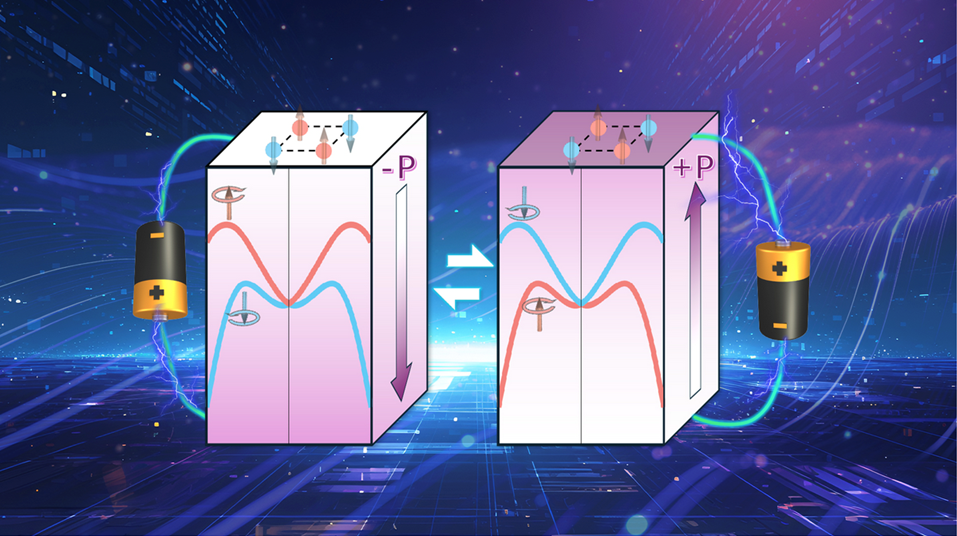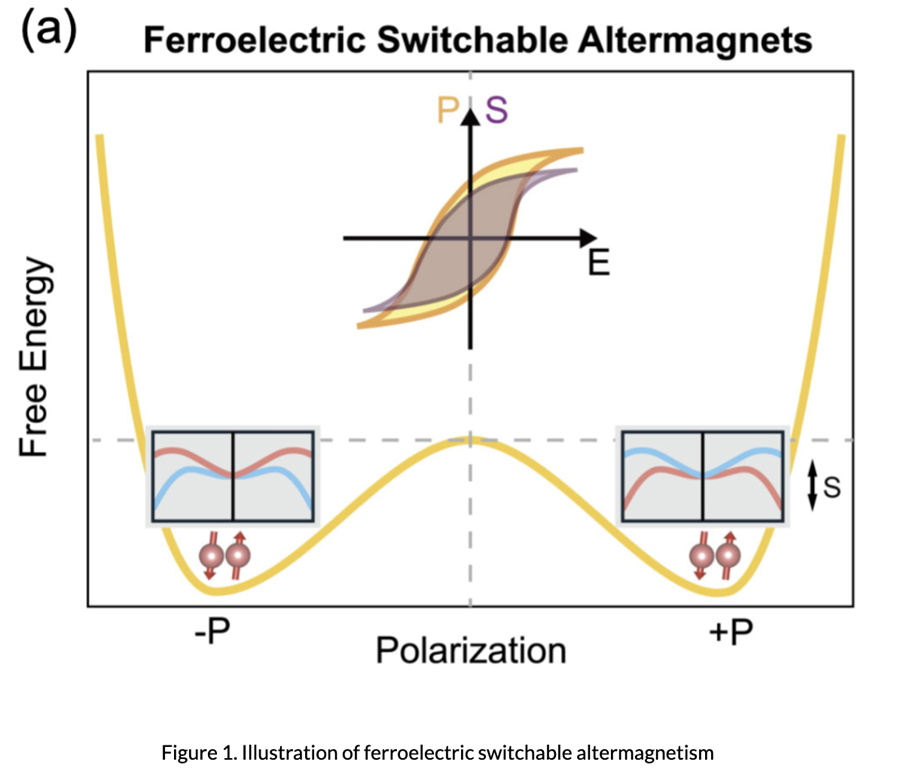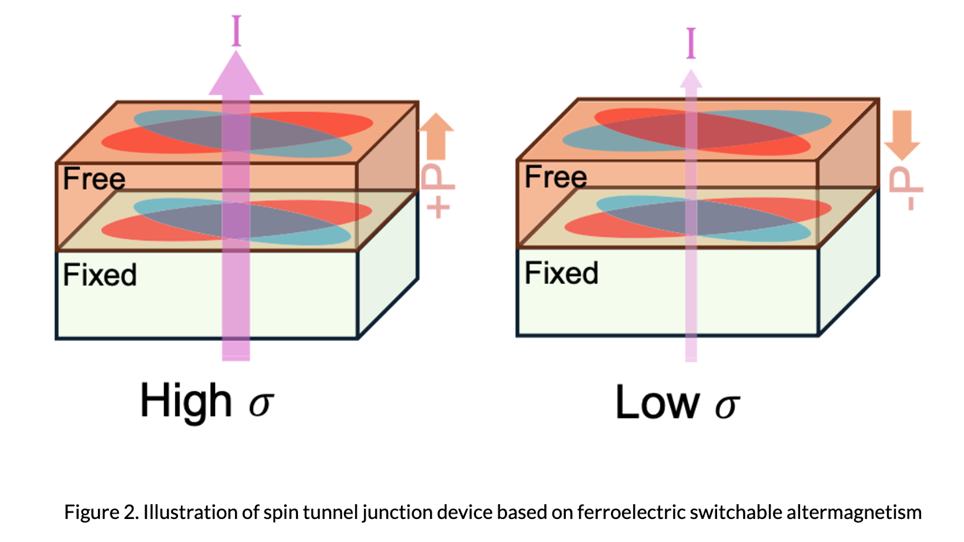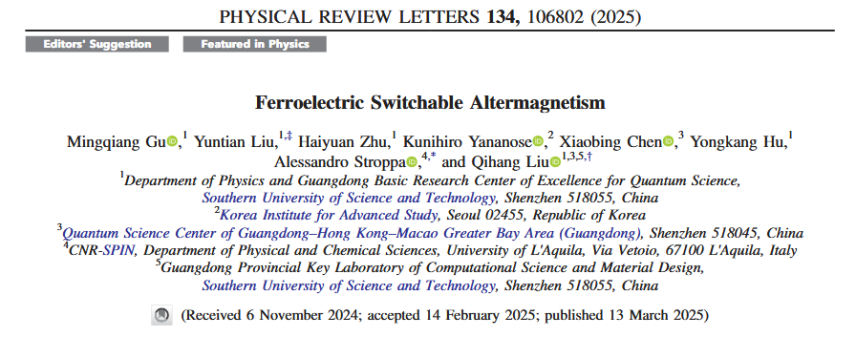An international collaboration led by Dr. Alessandro Stroppa (CNR-SPIN, Italy) and Prof. Qihang Liu (Southern University of Science and Technology, China), with researchers from the Korea Institute for Advanced Study, has achieved a groundbreaking advance in magnetoelectric materials.The team has discovered a novel phenomenon termed "Ferroelectric Switchable Altermagnetism," demonstrating for the first time the reversible electrical control of altermagnetic spin states through ferroelectric polarization switching. This fundamental breakthrough, published as an Editors' Suggestion in Physical Review Letters and featured in Physics, establishes a new mechanism for non-volatile electrical manipulation of magnetic order with the first theoretical demonstration of electrically tunable altermagnetic properties, and a transformative approach for developing fully voltage-controlled multiferroic devices.
The discovery opens unprecedented opportunities for next-generation spintronic memory and logic technologies, potentially enabling ultra-low-power magnetic storage and computing architectures.

Multiferroic materials are a class of multifunctional materials that exhibit both ferroelectricity and magnetic ordering. Traditional multiferroic materials are typically classified into two categories. In type-I multiferroics, ferroelectricity originates from orbital degeneracy lifting due to broken crystal symmetry, resulting in weak magnetoelectric coupling between spontaneous polarization and magnetic order. In type-II multiferroics, magnetic order and polarization are directly correlated via spin-orbit coupling mechanisms, such as the Dzyaloshinskii-Moriya interaction, which theoretically enables high magnetoelectric coupling coefficients. However, in most transition metal compounds, the strength of spin-orbit coupling is relatively weak (on the order of ~10 meV), making it challenging to achieve large magnetoelectric coupling coefficients.

Altermagnets have recently attracted significant attention as a class of unconventional magnets that combine the zero net magnetization of antiferromagnets with the spin-split band properties of ferromagnets, making them promising candidates for next-generation spintronic devices. However, achieving non-volatile electric field control of altermagnetism has remained an open challenge. Since altermagnetism does not rely on spin-orbit coupling, it provides a potential path to a novel magnetoelectric coupling mechanism distinct from type-II multiferroics.
The international team innovatively proposed the concept of ferroelectric switchable altermagnetism. Through spin group symmetry analysis, they uncovered a cooperative coupling mechanism between ferroelectric polarization and altermagnetic spin splitting. When the external electric field reverses the ferroelectric polarization P, the spin polarization of the split bands in momentum space is also simultaneously flipped (Figure 1). This magnetoelectric coupling phenomenon does not require altering the material’s antiferromagnetic order (Néel vector); rather, it is realized via the coupling between the electric field and the material’s structural deformation modes.
By screening through 2001 experimentally known magnetic structures from the MAGNDATA database, they identified 22 potential ferroelectric altermagnetic candidates. Among them, two promising materials—perovskite oxide Ca₃Mn₂O₇ and metal-organic framework (MOF) material Cr-MOF ([C(NH₂)₃]Cr(HCOO)₃)—stood out for exhibiting electrically switchable spin splitting. Taking Cr-MOF as an example, theoretical calculations indicate that reversing its ferroelectric polarization leads to a sign change in the spin splitting at the valence band maximum, with a maximum energy difference of up to 20 meV. Additionally, the energy barrier for ferroelectric switching is only 0.1 eV, demonstrating experimental feasibility.
Based on the concept of ferroelectric switchable altermagnetism, the research team designed a homojunction spin tunnel junction device (Figure 2). By reversing the ferroelectric polarization of the free layer via an electric field, the match/mismatch of spin-polarized Fermi surfaces between the free and fixed layers can be switched, achieving a giant magnetoresistance effect of up to 53%. This mechanism circumvents the need for antiferromagnetic order switching, as required in conventional antiferromagnetic spintronic devices, thereby significantly reducing energy consumption.

The researchers proposed utilizing linearly polarized light-induced spin currents to detect the switching of altermagnetism. Theoretical analysis reveals that Cr-MOF exhibits a nonzero Berry curvature dipole, which generates a direct current spin current of 0.23 µA/V² under 3.2 eV photon excitation. The sign of this spin current reverses with ferroelectric polarization, providing an experimentally viable approach for verification.
This study uncovers a novel magnetoelectric coupling mechanism based on unconventional magnetism by leveraging spin group theory, paving the way for the design of new systems for non-volatile memory and electrically controlled spintronic devices driven by magnetoelectric dynamics.
The first author of this paper is Associate Research Professor Mingqiang Gu at SUSTech. The corresponding authors are Professor Qihang Liu and Professor Alessandro Stroppa from the University of L’Aquila, Italy.
Paper: https://journals.aps.org/prl/abstract/10.1103/PhysRevLett.134.106802
“Featured in Physics” article in Physics magazine: https://physics.aps.org/articles/v18/58
